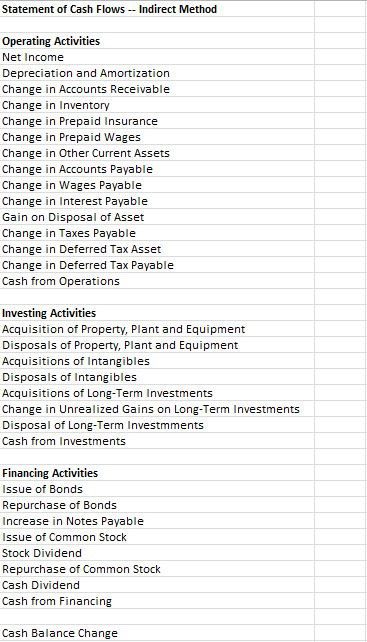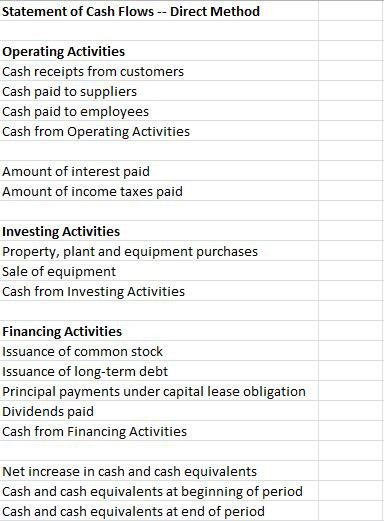A cash flow statement is a financial statement that shows how much money is going in and out of your small business. The statement is a part of a formal document that is included in your company’s financial statements. It breaks out your business’s cash flow in three categories: operating, investing and financing.
Conducting a statement of cash flows helps you see if your business is succeeding. Improperly managing your business’s money can lead to financial issues. An Intuit survey found 61% of small business owners struggle with cash flows. and 32% of small business owners couldn’t make various payments.
Business owners may fail to create a cash flow statement for a variety of reasons. They may not know how to prepare one, or they may not realize the benefits of doing so. Understanding how to create a cash flow statement—and how a statement of cash flows can help put your business in a better position to succeed—are important skills for you as a business owner.
Cash Flow Definition
The money going in and out of your business is called your cash flow. The quality and timing of the cash flow play an important part in a business’s success and growth.
If a business is spending more than it is taking in, this is considered a negative cash flow. This can prevent the business from expanding, or it may put the company at risk of closing. A business experiencing the opposite scenario would have a positive cash flow: The business is taking in more money than it is spending. As a business owner, it’s important to know that cash flow is different from profit.
Understanding what your cash flows look like can help you see where your money is going throughout the year. For example, say your business takes in $800,000 in a year. But you’re left wondering at the end of the year where that money is. Conducting a cash flow statement analysis can show you where that $800,000 ended up. It could show you that most of it was spent on paying vendors or for fixed assets.
As a rule of thumb, you should create a cash flow statement on a quarterly basis. You’ll see the change in your cash flows from quarter to quarter. By producing a quarterly statement, you may also be able to forecast your cash flow. This could help you better plan for future investments or payments to avoid financial issues.
So, how do you get started? The first thing you should know is that there are two different methods for putting together a cash flow statement: the direct method and the indirect method.
Increase Cash Flow Video
Cash flow is the life blood of your business. One of the biggest cash flow dilemmas that small businesses often face is late paying customers. From sending email reminders to setting up easy payment options or even using collection agencies there are many options to help you increase and maintain your cash flow.
Cash Flow Statement Indirect Method
The cash flow statement indirect method is the most common method used by businesses. The indirect method is easier to do and takes less time. Putting together a cash flow statement with this method gives you a general overview of where money came in from and where money was spent.
The cash flow statement indirect method takes a balance sheet approach to determining your cash flow. So, the starting figure is the net income from the current period. This number is then changed depending on revenue and expenses. These revenues and expenses are categorized by three activities: operating, financing, and investing. With the cash flow statement indirect method, you’ll see how much change there was with your business’s:
- Receivables
- Payables
- Inventories
- Fixed assets
- Other assets
- Equity accounts
- Long-term debt
The net cash flow from the three categories of activities is then added to the overall net income or loss of your business. At the end of the statement, you’ll see how all the changes in your balance sheet accounts affected cash—from where it was at the beginning of the period to what’s leftover at the end.
You can use Microsoft Excel to put together a cash flow statement using the indirect method. Here’s a cash flow statement example using the indirect method:
Cash Flow Statement Example Using The Indirect Method

As you fill in the values for the respective line items, you’ll see how it affects your net income. Here’s an example:

You’ll see your net income is $500,000. The value for each line item will positively or negatively impact this starting net income. For example, the depreciation and amortization take away $100,000 from your net income. The business had a positive change in accounts receivable, which adds $40,000 to your net income. In the above example, the 4 line items together negatively affect your net income by $130,000.
As you fill in the rest of the line items, you’ll see cash flows for each category. Adding or subtracting the cash from each category (the last line in each group) will give you the change in cash balance. If you have a positive change, it means you have extra cash and your business took in more revenue than expenses. If you have a negative change, your business spent more than it received in the period.
While it’s easier and faster to put together, the trade-off with the cash flow statement indirect method is that it doesn’t provide a detailed view of the cash flows. To get a detailed outlook on your cash flow statement—seeing exactly where money is coming in and what it is being spent on—you’ll have to use the direct method.
Statement of Cash Flows Direct Method
The statement of cash direct method isn’t used as often as the indirect. It takes more time to put together because it provides more specific details on your business’s cash flows while the indirect method gives you only a high-level overview of the amount of money that went in and out in specific categories.
The main difference is found in the operating activities category. If you use the cash flow statement example above, a statement of cash flows put together using the indirect method tells you the change you had in your accounts receivable in a year. The statement of cash flows direct method will tell you the specific amount of cash your business received from customers. It also will tell you the actual amount of money paid to your employees, vendors, and other operations.
At the bottom of a direct method statement of cash flows, the net income and expenses from the operating category are subtracted. This gives you the net cash flow for operating activities. This number is then changed, depending on the cash flow from investing and financing activities.
Similar to the indirect method, you can create a cash flow statement by using the statement of cash flows direct method in Microsoft Excel. Here’s one way to set it up:
Cash Flow Statement Example Direct Method

Each line item in the statement of cash flows direct method will have a specific amount of money that corresponds to the respective category. Here’s an example for the first four line items:

This business received $700,000 in receipts from customers. It also paid out $320,000 to suppliers and $400,000 to its employees. The business also received $200,000 from its operating activities. When the entire cash flow statement is complete, the direct method will show the reader the specific amount of money received or spent within each category. It also will show the reader the money the business started with at the beginning of the time period and the money left over at the end of the period.
Cash Flow Statement Template
You can put together a cash flow statement by yourself. If this is your first time creating the statement, consider working with an accountant. They can teach you how to put a cash flow statement together and then you can do it on your own to build quarterly statements. If you’re putting together a formal cash flow statement for inclusion in your business’s financial statements or other business presentation, then working with an accountant or finance professional could be a great help.
Before you create a cash flow statement for your business, you’ll need to decide if you want to use the cash flow statement indirect method or the direct method. When you’re submitting a financial statement for your business, you can use either method.
If you’re building your cash flow statement through the indirect method, you can download a cash flow statement template from the Corporate Finance Institute. The cash flow statement template is built in Microsoft Excel and gives you a good starting place to create a cash flow statement.
If you’re planning to create a more in-depth state of cash flows using the direct method, you can use the above example as a template.
Whatever cash flow statement template you use for your cash flow statement should outline your business’s operating, investing, and financing activities. It also should be organized and easy to read. Using Microsoft Excel also can help you ensure the math is done correctly.
Whether you use the cash flow statement indirect method or direct method to create your cash flow statement, it can be beneficial to you as a small business owner. You’ll be able to see where your money is going throughout the year. Examining your business’s cash flows also can help you forecast your cash flow for the following year—something that can better prepare you and set you up for future success.
Next steps: Interested in more small business marketing tips? Sign up for the Small Biz Ahead newsletter for the latest information about marketing tools, trends and resources.





